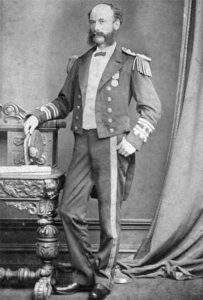The following are excerpts taken from the official report on the Voyage of HMVS Cerberus to Port Phillip: 1871 – 1872 by Commanding Officer, Lieutenant Panter RN

Photo courtesy of Henry Panter’s great grandson, David & Peg Orr.
Lieut Panter’s report is necessarily most comprehensive, however in the interests of brevity we paraphrase the following points of interest using his text.
On my arrival at Port Said I visited the canal authorities. As her steering qualities were so bad, I deemed it prudent to take a tug through the canal and after taking 198 tons of coal, I started at daylight on the 21st,and and arrived at Suez on the evening of the 23rd.I found, owing to her great beam under the water, 43ft, and her screws projecting so far out on each quarter, and also her bottom being only half an inch thick, that it was very dangerous work getting her through, for if her screws had touched they would have broken, and if her bottom had struck at all hard it would have bent it, so I only proceeded at the rate of two miles per hour. I just touched twice, but not hard enough to take the paint off her bottom. I made a very fair passage to Aden, where I arrived on the 6th of January, and after overhauling the engines and taking 400 tons of coal on board,200 tons of which I had to stow on my decks, I started again on the 14th for Galle. I had to sail nearly 600 miles up the coast to Arabia before I could stand out to sea, on account of the N.E. monsoon, which at this time of the year blows from the E.N.E. and then I kept away from Galle, arriving there on the 31st January. I sailed again on the 4th for Batavia.
I experienced very fine weather all the way, and arrived there on the 17th, and after cleaning the boilers and engines and taking on 305 tons of coal, I sailed on the 25th for Australia. Soon after leaving the Straits of Sunda I got into very rough weather, and for three days i was close to a hurricane. I had to run down the south-west side of it to avoid the centre, which would have been fatal to the ship, and consequently I had to go some distance out of my way; and when I got down to the western coast I had strong winds for three days .I was obliged to go into Fremantle and get enough coal to take me to the Sound, where i arrived on the 22nd of March, and after cleaning the ship’s bottom and coaling I sailed again on the 30th, and with the exception of the first two days I have had fine weather all the way. I sighted the Otway at half past 2pm on the 8th, and arrived in Hobson’s Bay at 1 pm on the 9th.
In conclusion, I have the honour to inform you that the principal causes of my anxiety during the whole voyage have been -1st. My never having had a trial, and therefore not knowing what stability the ship had; also the general idea amongst the officers, both at Admiralty and Chatham, Sheerness, Portsmouth and Plymouth dockyards, that she was not fit for a sea-going ship, and further ,the bad steering qualities of the ship, as when it was blowing I seldom got her to steer within three or four points of her course each way, and consequently at times she would get into the trough of the sea, which made it very dangerous, as I have had nearly the whole way upwards of 2000 tons of weight above my water line, and only 1800 below it. -2nd. Her sails being almost useless to her, I always had to trust my engines, and at times I had had to carry 154 tons of coal on my upper deck, which made her roll very heavily.
Reference:
Official Report of Lieutenant Panter, HMVS Cerberus, Geelong Advertiser, 15 April 1871, available through Trove



